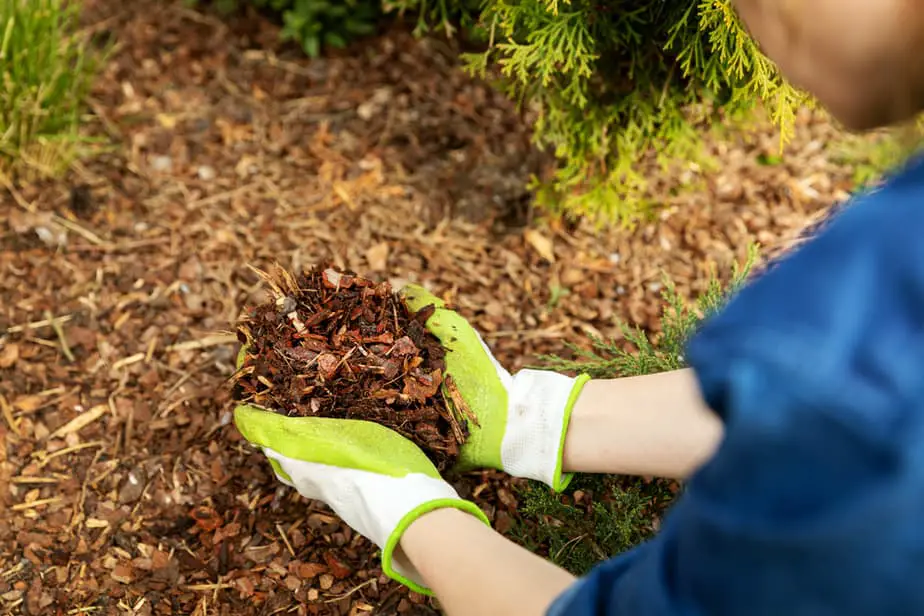Mulch is often a biodegradable material, layered over a garden bed to protect it, add nutrients, or act as a decorative feature. It can be used all year round or seasonally, depending on your climate. It helps retain moisture, and much like composting, mulching is a useful garden tool.

Table of Contents
Are There Benefits to Mulching?
Depending on the material being used as a garden mulch, the benefits vary. For example, a pea straw will prevent the soil from drying out. As it decomposes, it adds extra nutrients to the soil. Although before that happens, it may, as it did for me, start shooting and grow lots of little pea plants. Although this may look pretty, most people treat them as a weed and remove them from the mulch.
In colder climates or colder seasons, mulch has the opposite effect and acts as insulation for the soil, protecting the root systems of plants while keeping the ground a little warmer.
Mulches like pine/wood chips or crushed stones can be used for decorative purposes. These make just about every gardener happy because they help stop weed growth. They decompose slower, which makes them economical to use.
Types of Mulch
Mulches can be roughly classified as follows:
- Biodegradable
These tend to be finer mulches that put nutrients into the soil. They include hay, pine straws, pea straw, and lawn clippings. They help retain soil moisture.
- Somewhat Degradable
These are often a bit chunkier and include wood chips, bark, cocoa shells, and pine needles.
- Decorative/Non-Organic
These are more substantial and include pebbles, crushed rocks, and even rubber pieces (used more for playgrounds than gardens).
How Deep Mulch Should Be
The depth of your mulch layer varies greatly and depends on the type of mulch you are using. If your mulch layer is too deep, it stops any water or sunlight from getting to the soil underneath, killing your garden rather than improving it; too shallow, and it can be washed or blown away too easily, leaving your plants exposed.
There is little preparation required before laying your mulch layer. If there are as few weeds as possible, the mulch will suffocate what is left, providing you put the mulch directly on the weeds and don’t cover around the base of garden plants.
A general rule of thumb is around 2-3 inches deep of mulch on a garden bed after settling, so try starting with 4 inches. As you water your beds, the more lightweight mulch particles will begin to settle into the soil, so you will need to replenish the layer over time. This type of mulch will need topping up more frequently as the old layer of mulch starts to decompose. There is no need to remove the old mulch. It can be turned into the soil as compost.
Woodchip based mulches will look quite deep when you first lay them out, but will also settle, so be generous. After settling, your woodchip layer should stay at a consistent depth – around 2-3 inches deep works well for this type of mulch.
The least degradable mulch of all – a pebble/stone layer – will not need to be very deep at all (2 inches at most), and can be left for years. Its only risk is if you have used pretty pebbles and small children take them to use as gifts or to play with. This type of mulch is more for decorative purposes than soil preservation so that it would work better on a pathway than around trees.
The amount you use will also depend on which season you are laying out your mulch.
A thin layer of organic mulch in winter is not going to protect your plants as effectively as a thicker one. In contrast, a thick layer of mulch in the spring will block the heat plants need to grow and stop the soil around them warming up. As the summer approaches, you will want to protect your plants with a thicker layer to help prevent moisture evaporation.
It is wise to take care when laying your mulch. By laying it too closely to your plant trunks and around trees, it can kill them.
Conclusion
Is it worth the effort? For a healthy, tidy garden, mulching certainly does help. The amount you will need will be dependent on the type you use and why you are using it. Like farmland, your soil will benefit from a biodegradable source of nutrition. It helps lower the amount of water your plants require in summer and helps insulate in winter.
When considering mulches, your best advisers will be your local suppliers, who know your climatic conditions and the soil types in your area. They will be able to give you specific advice about how much mulch you will need for your particular gardening needs.
